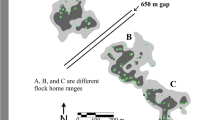Summary
-
1.
A series of experiments using flocks of model birds on natural foraging grounds in Panama was designed to test whether each species participating in mixed heron flocks was drawn to the flock by resources alone, by the presence of members of its own species, by the presence of other species, or by the white color of flock participants.
-
2.
The presence of Snowy Egrets was determined to be the attractive force. Field observations revealed that herons of all participating species increased their foraging success by proximity to Snowy Egrets (Fig. 1). Stomach-content analysis and direct observations revealed complete dietary overlap among all participating species. There was no significant difference in mean foraging rates of any species, except for adult Little Blue Herons, which caught fewer fish than even immature members of their own species. Adult but not immature Little Blue Herons were selectively attacked by other species, and foraged farther from Snowy Egrets in the flocks.
-
3.
Benefits of mixed flocking accrue to Great Egrets, Little Blue and Tricolored Herons by increased foraging success when foraging close to Snowy Egrets; Snowy Egrets benefit by using subordinate species as easily supplanted indices of temporally varying food.
Similar content being viewed by others
References
Altmann SA, Altmann J (1970) Baboon ecology, African field research. University of Chicago Press, Chicago
Armstrong EA (1970) Social signalling and white plumage. Ibis 113:534
Austin GT, Smith EL (1972) Winter foraging ecology of mixed insectivorous bird flocks in oak woodland in southern Arizona. Condor 74:17–24
Bertram BCR (1978) Living in groups: predators and prey. In: Krebs JR, Davies NB (eds) Behavioural ecology. Sinauer, Sunderland, MA, pp 64–96
Caldwell GS (1979) Social dynamics of foraging herons and egrets in tropical mixed-species flocks. Ph D dissertation, University of California, Berkeley
Caldwell GS (1980) Underlying benefits of foraging aggression in egrets. Ecology 61:996–997
Cody ML (1971) Finch flocks in the Mojave Desert. Theor Popul Biol 2:142–158
Greig-Smith PW (1978) Imitative foraging in mixed-species flocks of Seychelles birds. Ibis 120:233–235
Krebs JR (1973) Social learning and the significance of mixed-species flocks of chickadees (Parus spp.). Can J Zool 51:1275–1288
Krebs JR (1974) Colonial nesting and social feeding as strategies for exploiting food resources in the Great Blue Heron (Ardea herodias). Behaviour 51:99–134
Krebs JR (1978) Colonial nesting in birds, with special reference to the Ciconiiformes. In: Sprunt A, Ogden JC, Winckler S (eds) Wading Birds, Research Report No 7 National Audubon Society, New York, pp 219–314
Kushlan JA (1977) The significance of plumage colour in the formation of feeding aggregations of Ciconiiformes. Ibis 119:361–364
MacDonald DW, Henderson DG (1977) Aspects of the behaviour and ecology of mixed-species bird flocks in Kashmir. Ibis 119:481–491
Meyerriecks AJ (1960) Comparative breeding behaviour of four species of North American herons. Publ Nuttall Ornith Club 2:1–158
Morse DH (1970) Ecological aspects of some mixed-species foraging flocks of birds Ecol Monogr 40:119–168
Moynihan M (1962) The organization and probable evolution of some mixed-species flocks of neotropical birds. Smithson Misc Collect 143:1–140
Rand AL (1954) Social feeding behavior of birds. Fieldiana Zool 36:1–71
Recher HF, Recher JA (1969) Comparative foraging efficiency of adult and immature Little Blue Herons (Florida caerulea). Anim Behav 17:320–322
Rubenstein DI, Barnett RJ, Ridgely RS, Klopfer PH (1977) Adaptive advantages of mixed-species feeding flocks among seedeating finches in Costa Rica. Ibis 119:10–21
Russell JK (1978) Effects of interspecific dominance among egrets comensally following roseate spoonbills. Auk 95:608–610
Short L (1961) Interspecies flocking of birds of montane forest in Oaxaca, Mexico. Wilson Bull 73:341–347
Ward P, Zahavi A (1973) The importance of certain assemblages of birds as “information-centres” for food finding. Ibis 115:517–534
Willis EO (1972) The behaviour of spotted antbirds. AOU Ornithol Monogr 19:1–162
Willis EO (1973) The behavior of ocellated antbirds. Smithson Contrib Zool 144:1–57
Wilson EO (1975) Sociobiology. Belknap Press, Cambridge
Author information
Authors and Affiliations
Rights and permissions
About this article
Cite this article
Caldwell, G.S. Attraction to tropical mixed-species heron flocks: Proximate mechanism and consequences. Behav Ecol Sociobiol 8, 99–103 (1981). https://doi.org/10.1007/BF00300821
Received:
Accepted:
Issue Date:
DOI: https://doi.org/10.1007/BF00300821




